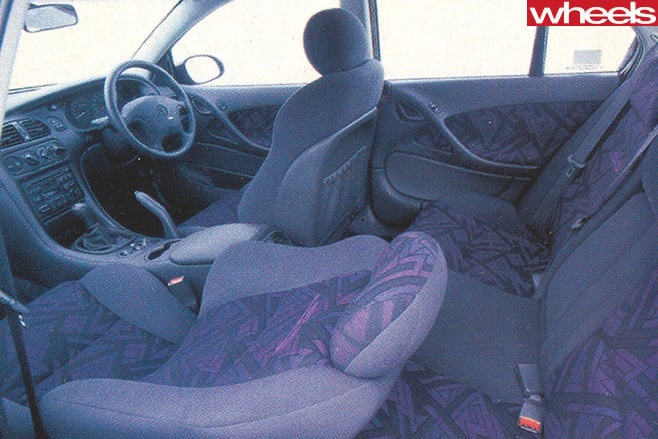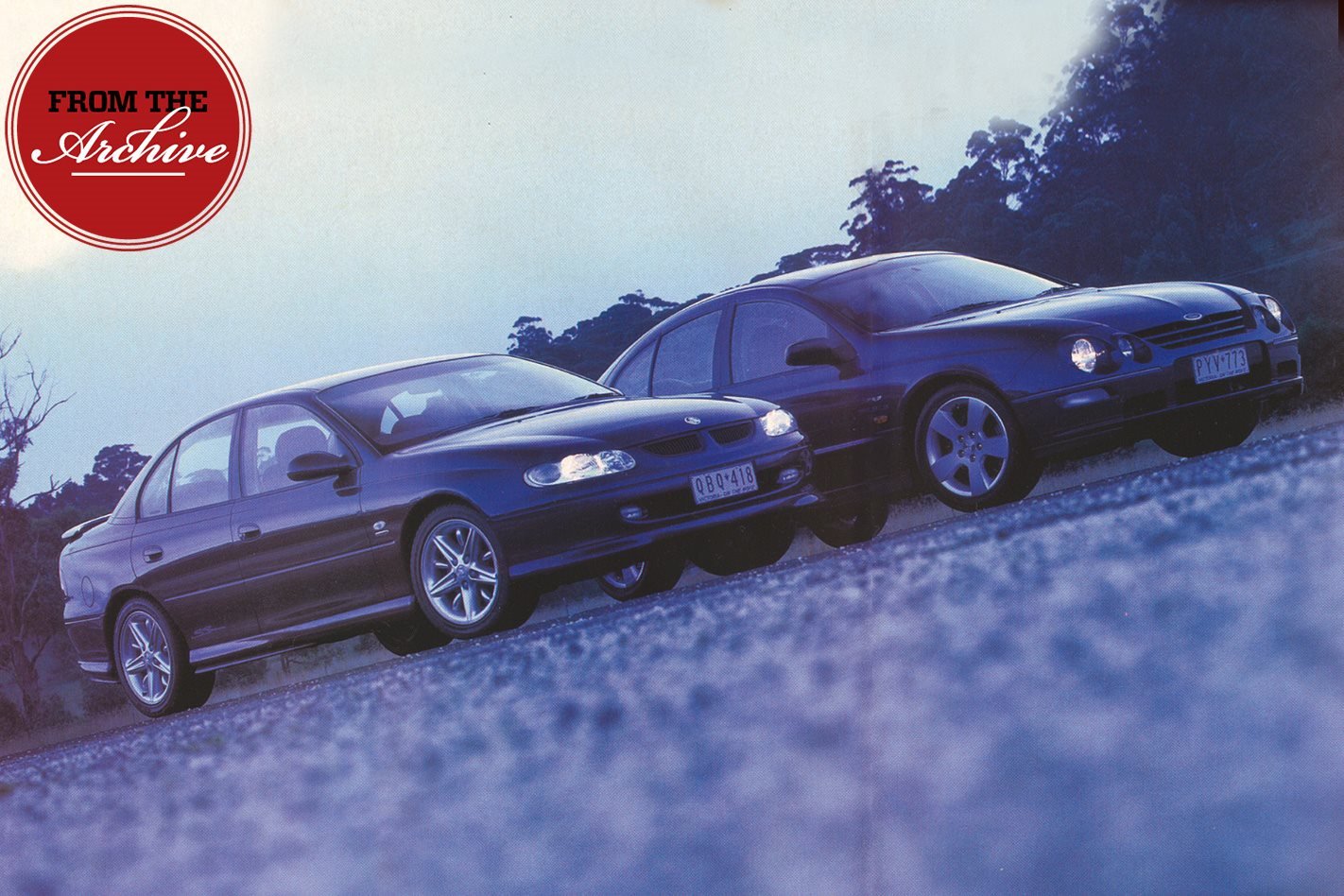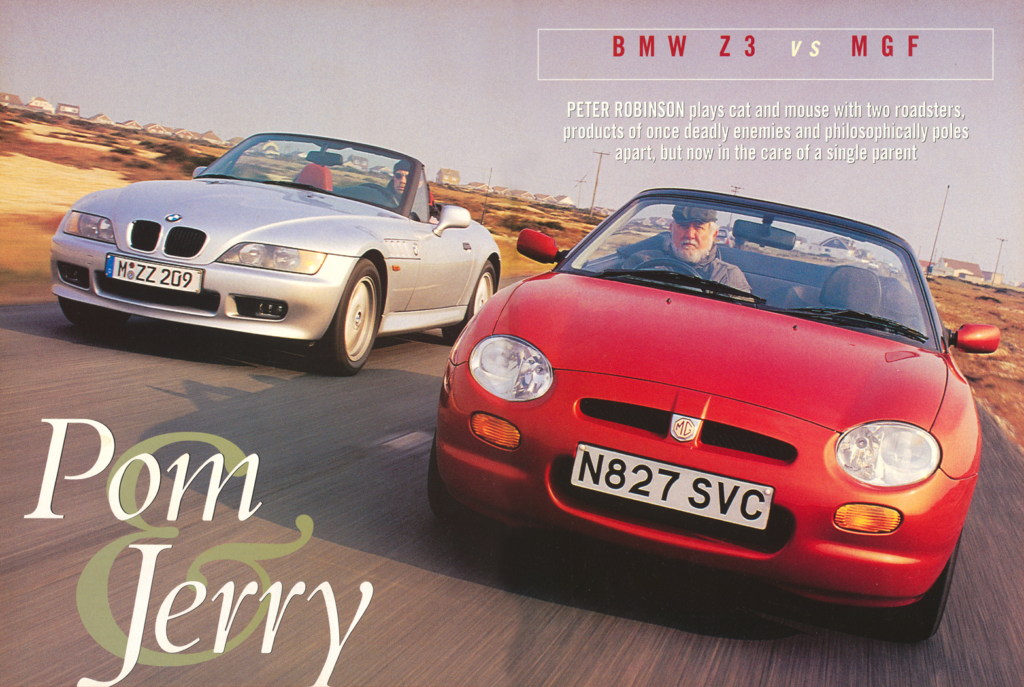Ford wants you, please, to reconsider its AUII XR8. There are 200 reasons why you should, writes Fraser Stronach.
First published in the June 2000 issue of Wheels magazine, Australia’s most experienced and most trusted car magazine since 1953.
For Aussie V8 buyers pride depends largely on two things, power and time. Every kilowatt added, every tenth of a second subtracted. Already whipped once in a comparison test by the VT Series II SS, Ford has a new, smoothed-over and powered-up AUII XR8 to make up for lost time. Ford has beefed up its V8’s previous numbers, 185kW and 412Nm, to more satisfactory 200kW and 420Nm. The image makers have also been at work, the XR8 sporting a refreshed front-end, spoiler, 17in alloys and optional body kit.
Meanwhile, Holden has had its feet up. With 5.7litres and 220kW of alloy V8 happily ensconced under the SS bonnet, (and customers queuing to buy it) you can hardly expect it would do anything else. Power and time is on Holden’s side. But for how much longer?
In their last contest (Wheels, September 1999) the extra grunt of the 5. 7 litre Chev eight was enough to bury the 185kW XR8. A full second faster in the 400 metre sprint and a crushing 3.2 seconds faster to 140km/h, the SS was clearly the straight-line king. This should have been sufficient to produce a decisive knockout but the Ford responded with a hard and timely counterpunch in the form of its superior chassis dynamics. A points decision.

With a lower first gear and less axle tramp, the 200kW AUII jumped harder again, seeing 60km/h in just ‘ 3.3 seconds. Bit by bit, however, the Holden’s 20kW advantage starts to show. Both reach 80km/h in the same time but the Ford is 0.4 seconds slower to 100km/h and 0.3 seconds slower over the 400, stopping the clock at 15.3 seconds. Marginally slower it may be, yet the XR8 has made up much ground on the SS. In anyone’s language a 0.3 second shortfall over the 400 metres is better than a full second.

Neither gearbox is super slick. The Holden’s six-speeder is not a close ratio unit but more like a standard five-speeder with a moonshot sixth added. This is overdrive taken to the extreme and gives around 68km/h per 1000rpm. Yes, work it out. At the legal max in most states the engine is barely off idle. The SS box is notchy and the gate is not as well defined as it should be. The Ford has a more positive gate, a sweeter but still slowish shift, and outside of the Holden’s sixth, a wider spread of ratios.

Both engines are silky smooth at low to middling revs, as only 90 degree V8s can be, but become a little harsh closer to their respective redlines. The Ford sounds like a ‘real’ V8, its exhaust note from both inside and outside the car an aural delight. Not so the Generation III Chev, which sounds muted and non-V8 like at times.

The Holden boasts the better straight-line steering. It’s more direct and not too heavy. The Holden turns in more crisply and quickly, but that quick steering soon translates to a slightly nervous and unsettled mid-corner feel. The Holden requires more work from the driver and takes longer to get to know. Exiting a comer, too, requires a more sensitive right foot.

Both cars run on 235/45 rubber mounted on 17×8 inch alloys. There’s generous grip from both the Ford’s Dunlops and the Holden’s Bridgestones and the road shock isolation, too, is surprisingly good given how little sidewall separates road from metal. The Holden has the edge in overall ride quality, but there’s really little in it between the pair.

The XR8 was also fitted with optional leather making its interior an altogether more appealing environment than that of the Commodore. The Ford’s instrumentation extends to oil pressure and battery condition gauges while a CD player is standard in the Ford, optional in the Commodore. For its part the SS has equally comfortable seats with the bonus of electric height adjustment. The ‘SS’ emblem on each seat seems out of character, however, with the rather conservative style of the rest of the car. Interior dimensions are similar although rear seat passengers in the Ford are better catered for, even if it is at the expense of front seat adjustment. The Ford’s boot is also marginally bigger.

The SS starts out at $46,650 with our test vehicle adding side airbags ($480), CD player ($450) and metallic paint ($233) to bring the price up to $47,813. The Holden is cheaper to buy, more expensive to own.

Both these cars are enormously entertaining to drive. They have an undeniable presence on the road. Yes, they tum heads. Courtesy of their size and ancestry they also offer practical day-to-day family transport. The Holden has the grunt and the more conservative styling that will probably endear it to more people. The Ford feels sweeter on the road, but its love it or leave it front end styling may turn off some prospective buyers. The SS also felt tighter and better built, but the Ford had covered twice the distance with a hard-driven 8000km on its odo.
There’s barely a struck match between these two. The Holden still holds a marginal straight-line speed advantage, but the Falcon is the better drive. It’s not how much you’re got but how you use it.
Price
| u00a0 | Ford Falcon XR8 | Holden Commodore SS |
| Basic/as tested. | $48,965/$57,485 | $46,650/$47,813 |
Engine
| u00a0 | Ford Falcon XR8 | Holden Commodore SS |
| Layout | Longitudinal V8, ohv, 16v | Longitudinal V8, ohv, 16v |
| Induction | Fuel injection | Fuel injection |
| Capacity(litres) | 4.942 | 99.0/92.0mm |
| Bore/stroke | 101.6/76.2mm | 10.0:1 |
| Compression ratio | 9.1:1 | 6894 |
| Max. power | 200kW at 5000rpm | 200kW at 5000rpm |
| Max. torque | 420Nm at 3750rpm | 446Nm at 4400rpm |
| Redline/cut-out | 5750/6000rpm | 5500/6000rpm |
Transmission
| Ratios (km/h@1000rpm | Ford Falcon XR8 | Holden Commodore SS |
| u00a0 | 5-speed manual | 6-speed manual |
| First | 2.95 (11.5) | 2.66 (12.7 |
| Second | 1.94 (17.5) | 1.78 (19.0) |
| Third | 1.34 (25.3) | 1.30 (26.1) |
| Fourth | 1.00 (34.0) | 1.00 (33.9) |
| Fifth | 0.73 (46.5) | 0.74 (45.8) |
| Sixth | u00a0 | 0.50 (67.7) |
| Differential Ratio | 3.45 | 3.46 |
Suspension
| u00a0 | Ford Falcon XR8 | Holden Commodore SS |
| Front | A-arms, coil springs, anti-roll bar | struts, coil springs, anti-roll bar |
| Rear | Upper and lower A-arms, coil springs, anti-roll bar | semi-trailing arms, coil springs, anti-roll bar |
| Tyres | 235/45ZR17 Dunlop SP Sport 9000 | 234/45ZR17 93V Bridgestone B530 |
Brakes
| u00a0 | Ford Falcon XR8 | Holden Commodore SS |
| Front | Ventilated discs, ABS | Ventilated discs, ABS |
| Rear | discs | discs |
Steering
| u00a0 | Ford Falcon XR8 | Holden Commodore SS |
| Steering type | Power-assisted, rack & pinion | Power-assisted, rack & pinion |
| Turns lock to lock | 3.1 | 2.5 |
| Turning circle (m) | 10.9 | 11 |
Vital Stats
| Front track | Ford Falcon XR8 | Holden Commodore SS |
| Wheelbase | 2793mm | 2788mm |
| Rear track | 1566mm | 1569mm |
| Length | 1870mm | 1587mm |
| Width | 1547mm | 4884mm |
| Weight | 4907mm | 1636kg |
| Fuel tank | 68 litres | 75 litres |
Performance
| Standing start, time in seconds | ||
| 0-60 km/h | 3.3 | 3.3 |
| 0-80 km/h | 5.2 | 5.2 |
| 0-100 km/h | 7.3 | 6.9 |
| 0-120 km/h | 10.2 | 9.6 |
| 0-140 km/h | 13.9 | 12.4 |
| 0-400m (km/h) | 15.3 (145.3) | 15.0 (152.3) |
Fuel consumption
| Average (L/100km) | 13.5 | 13.7 |





